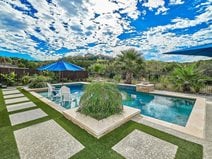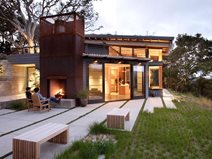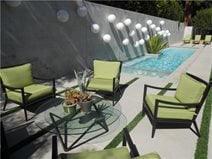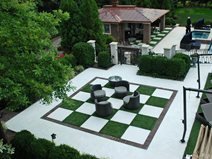- Staining Concrete
- Stamped Concrete
- Concrete Overlays
- Concrete Resurfacing
- Concrete Polishing
- Concrete Dyes
- Colored Concrete
- Indoor Concrete
- Concrete Floors
- Concrete Countertops
- Garage Floor Coatings
- Furniture, Sinks, Fire Bowls
- Basement Floors
- Outdoor Concrete
- Concrete Patios
- Concrete Driveways
- Concrete Pool Decks
- Outdoor Kitchens & Counters
- Outdoor Fireplace
- Concrete Walkways
- Concrete Pavers
- Concrete Walls
- Repair & Maintenance
- Foundation Repair
- Concrete Crack Repair
- Concrete Sealers
- Building with Concrete
- Concrete Homes
- Concrete Basements
- Decorative Concrete
- Fire Resistant
How to Use Grass Accents for Concrete Driveways, Patios & More
Get 11 ideas for using grass to bring color and vibrancy to your concrete pavement designs.Installing strips of grass or other greenery between slabs of concrete is a clever technique for turning an ordinary driveway, pool deck or patio into a lush, vibrant surface. This eye-catching combination is also easy to achieve, even by a do-it-yourselfer. You simply plant grass or lay strips of artificial turf in between large concrete pavers or poured-in-place slabs to create diamond grid designs, crisscrossing lines, faux stepping stones, and other patterns. Here’s a look at a few of your design options, along with tips for installing and maintaining grass-accented concrete.
Find decorative concrete contractors near me
 SUNDEK of Austin in Round Rock, TX
SUNDEK of Austin in Round Rock, TX
1. Pool Deck “Stepping Stones”
This modern take on a traditional concrete pool deck uses oversized concrete pavers separated by strips of artificial turf to create the look of large stepping stones. For greater realism, you can apply a textured coating to the concrete to give it a stone-like texture.
 Captain Concrete Inc. in Abbotsford, BC
Captain Concrete Inc. in Abbotsford, BC
2. Natural Driveway Joints
Instead of cutting control joints in a concrete driveway, consider using narrow strips of grass to separate slab sections. Not only do the grass strips provide natural crack control, they also improve drainage by soaking up water runoff.
 Envirocrete Inc in Calgary, AB
Envirocrete Inc in Calgary, AB
3. Diamond-Patterned Patio
Cutting diamond patterns into concrete is an easy, cost-effective way to give a plain concrete slab an upscale appearance. Instead of creating the pattern using sawcuts, you can achieve a similar look using grass and concrete pavers laid in a diamond pattern. The grass has a softening effect and helps tie the pavement in with the surrounding landscape.
 Feldman Architecture in San Francisco, CA
Feldman Architecture in San Francisco, CA
4. Bands of Thyme
This linear patio design combines rows of concrete and bands of creeping thyme to carry the lines from the interior flooring outdoors to the patio. Not only is creeping thyme an attractive alternative to grass, it’s also durable underfoot and requires very little maintenance.
 Artcon Decorative Concrete in Hamilton, MT
Artcon Decorative Concrete in Hamilton, MT
5. Modern Concrete and Grass Driveway
Another idea for a grass-accented concrete driveway is to use large, square concrete pavers and set them point-to-point to form a crisscross design. Complete the setup by filling the spaces between the pavers with artificial turf, which will stand up better to vehicle traffic than real grass. Get more design ideas for modern concrete driveways.
 ConcreteNetwork.com
ConcreteNetwork.com
6. Concrete Paver and Grass Patio
A simple design idea for a concrete and grass patio is to install a series of square pavers, leaving wide gaps between them. For the best effect, you should make the gaps at least 4 inches wide, which will allow plenty of room for the grass to grow and create the perfect balance of hardscape and softscape.
 ConcreteNetwork.com
ConcreteNetwork.com
7. Modern Lines
A narrow concrete deck for a lap pool is punctuated by parallel lines of grass that extend from one side of the pool to the other to provide visual continuity. The grass also adds much needed greenery to this otherwise lawn-free yard.
 ConcreteNetwork.com
ConcreteNetwork.com
8. Welcoming Entryway
Long, rectangular concrete slabs arranged in an offset pattern are interplanted with a creeping groundcover to create an inviting entryway. Groundcovers are a great choice for areas that would be difficult to mow. Plus, they provide a softer, more informal look than grass or artificial turf. Get more front entryway ideas.
 Decorative Concrete Inc in Fort Worth, TX
Decorative Concrete Inc in Fort Worth, TX
9. Relaxation Zone
For this concrete pool deck, grass-accented concrete was used to create a zone for rest and relaxation set apart from the rest of the slab. The concrete and grass are arranged in a tile-like pattern, making the patio appear to be an extension of the home interior.
 1 Man and a Toolbelt in Atlanta, GA
1 Man and a Toolbelt in Atlanta, GA
10. Grassy Walkway
This very simple but effective sidewalk design replaces the joints between concrete slabs with wide strips of grass. To add a touch of formality, both sides of the walkway are flanked by boxwood shrubs. See more design ideas for concrete walkways and sidewalks.
 Unique Concrete in West Milford, NJ
Unique Concrete in West Milford, NJ
11. Checkerboard Effect
Checkerboard patterns are becoming increasingly popular in modern outdoor patio designs. Here, squares of white concrete are alternated with equal-size sections of artificial grass. Because synthetic grass needs no irrigation or maintenance, the patio furniture can stay in place all season.
Is grass between pavers a good idea?
Planting grass between pavers or slabs of concrete can be a great idea because it softens harsh lines, improves drainage, and adds color and textural contrast. It can also enhance the curb appeal of your home by providing an aesthetically pleasing transition between your hardscaping and the rest of your landscape. However, you should consider the overall style of your home and how the pavement will be used. If the area will see a lot of foot or vehicle traffic, grass between pavers can become trampled and damaged. For these applications, artificial turf may be a better option.
Is it hard to maintain grass between concrete?
Like your lawn, the grass growing between slabs of concrete will need to be mowed or cut with a string trimmer on a regular basis. It will also need watering during dry weather. If you’re looking for a no-mow option for infusing real greenery into your concrete pavements, consider planting low-growing perennial groundcovers. Examples include creeping thyme, blue star creeper, dymondia and dwarf mondo grass, an evergreen groundcover that looks similar to turf.
What is the best grass to plant between pavers?
The answer often depends on your climate, the level of sun exposure in the planting area, and the amount of traffic the pavement receives. To minimize maintenance, look for slow-growing grasses that can handle a lot of foot traffic, such as Zoysia grass. A mixture of perennial ryegrass and Kentucky bluegrass also works well and is adaptable to a wide range of climates. You can either plant the grass from seed or trim a piece of sod to the desired width and length and lay the grass in between the pavers over a base of topsoil and compost.
Are there advantages to using artificial grass?
Unlike natural grass, artificial turf can be installed anywhere, doesn't require continual maintenance, and remains green year-round. You will also get immediate results without having to wait for the grass to grow and fill in. Because artificial grass has a permeable backing, it dries quickly and provides good drainage, making it ideal for pool deck installations.
Can I get this look with an existing concrete slab?
It’s best to start with concrete pavers that you place in the desired pattern before proceeding with grass installation. However, it is possible to cut gaps into an existing concrete slab to create the look of pavers. See these how-to tips from SUNDEK for incorporating grass into an existing slab.





